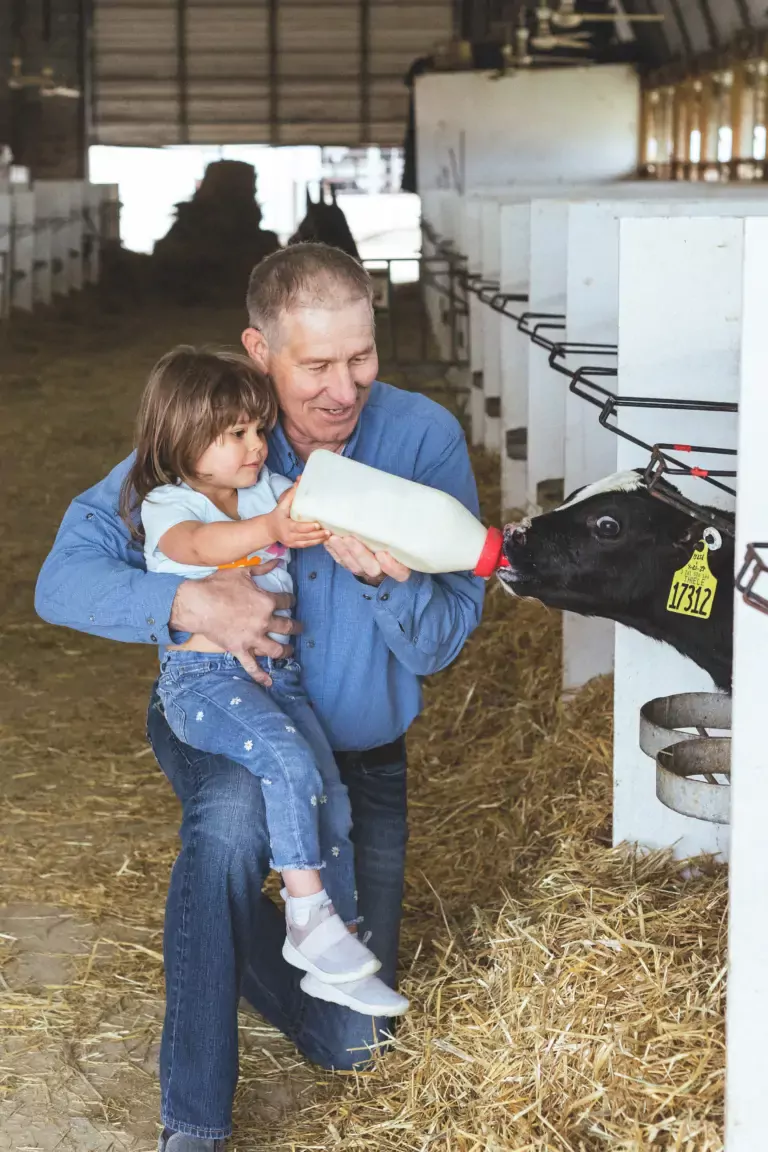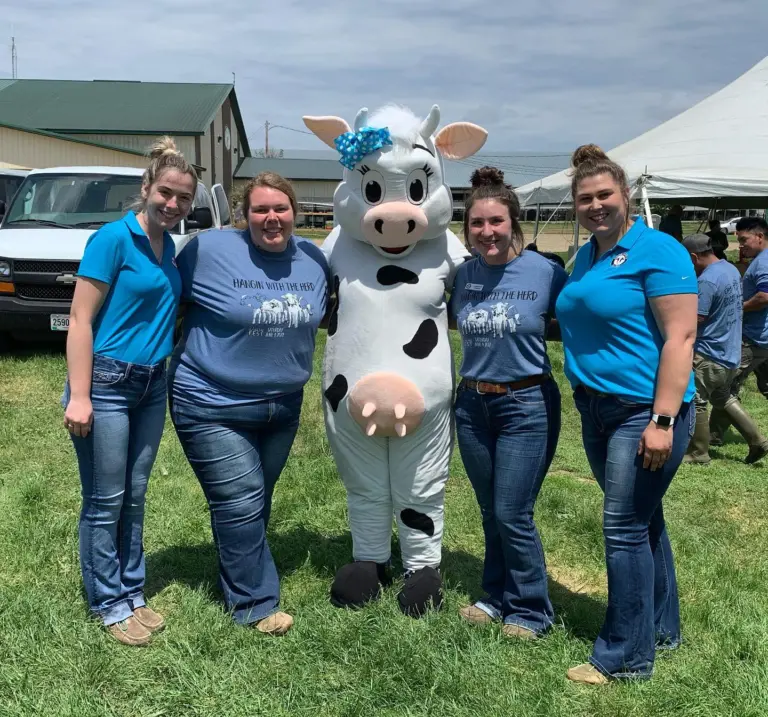
About Midwest Dairy and Promotion
No. The dairy checkoff program was created to increase demand of dairy foods over time. While dairy promotion is not able to influence milk prices, there are a number of areas where we work on the behalf of dairy farmers, including consumer education, issue and crisis management to maintain public confidence and nutrition, product, food safety and consumer research to name a few. Learn more about the role of dairy checkoff.
The work of Midwest Dairy is guided by the Board of Directors, who are elected by dairy farmers who contribute to dairy checkoff. Board members represent all 10 states and are elected to serve, first on the division board before being eligible to serve on the Corporate board. Some of Midwest Dairy board members also serve on the board of Dairy Management Inc. (the national dairy checkoff), allowing local input on the development of national campaign promotion programs.
All board members represent their fellow dairy farmers. You can find a complete list of board members in the About Us section.
Dairy checkoff is working to build trust in and demand for dairy at the both the local and national level. You can learn more how Midwest Dairy is working on behalf of dairy farmers by building trust and demand in dairy. Visit usdairy.com to learn about national efforts. You can also reach out to your local Farmer Relations team member with questions.
Meet our Farmer Relations team.
Midwest Dairy offers multiple resources to help dairy farmers promote dairy at the local level. We offer workshops to help you share your dairy story and engage with consumers as well as leadership grants to be used for developing skills and strategies to tell your dairy story. You can find a month-by-month engagement guide with ideas on how to bring dairy to life in your own community. There’s also a library of resources you can use when hosting an event on your farm or visiting a classroom. We offer promotional items to help you create an excellent dairy experience in our Promo Center as well as grants that you may be eligible for.
Yes! Provide a bit of dairy flair with fun dairy-themed promotional items, such as coloring books, cow hats, bookmarks and farmer calling cards. Order yours in the Promo Center. If you are hosting an event, you may be eligible for a grant from Midwest Dairy. Check out the guidelines for Undeniably Dairy Grants.
Midwest Dairy can help our partners create an excellent dairy experience in the dairy aisle to drive sales. We offer consultation on reinventing the dairy case, the latest in dairy research, consumer insights and trends. Learn more!

Young Dairy Leaders
The Midwest Dairy Ambassador Program is designed to build future dairy champions. There are Midwest Dairy Ambassador Programs in Illinois, Iowa, Minnesota, Nebraska, North Dakota and South Dakota. Learn more about the program in each state’s Dairy Ambassador Program here.
The Dairy Ambassador Program is an educational and leadership opportunity for those who are passionate about dairy. Dairy Ambassadors will have the opportunity to connect with consumers at local events such as state fairs, farm tours, ag days and more, and share dairy’s story while networking with their peers and industry professionals.
Dairy Ambassadors receive a per diem for each day they are participating in events. Additionally, Ambassadors are eligible to apply for a $1,000 scholarship at the end of their term.
Not all Midwest Dairy states have a Dairy Princess Program. Learn more about the programs on the Dairy Princess page.
Each state that offers a Dairy Princess program has different requirements and application processes. See the requirements for your state on the Dairy Princess page.
Yes! Midwest Dairy offers scholarships to students who are from dairy farms or pursing a dairy-related course of study. Scholarship eligibility and awards vary by state. See the current scholarship opportunities in the Scholarship section.
There are! Internships are available in different locations and within different areas of Midwest Dairy. You can check out what’s available on our internship page.
Check out our Dairy Research and Trends page.
Of course! Check out the stories of Midwest Dairy farmers. We also have stats and information about the number of dairy farms in the Midwest and the economic impact on local communities. We would love for you to share these stories and information with your customers in stores and online.
Dairy is local. In fact, it only takes about 48 hours for milk to travel from the farm to the store.
We would love to talk with you! Find a Midwest Dairy team member near you.

Wellness and Nutrition
The Dietary Guidelines for Americans (DGA) recognizes that milk and milk products are linked to improved bone health, especially in children and teens, and a reduced risk of cardiovascular disease, type 2 diabetes and high blood pressure in adults. The DGA calls for families to increase their intake of low-fat or fat-free milk, cheese and yogurt, with a goal of three servings every day for people ages nine and older.
Yes! Lactose intolerance doesn’t have to mean dairy intolerance. And dairy nutrition facts from many health authorities show that milk and other dairy foods are an important and practical source of essential nutrients for all people—including those who are lactose intolerant. People who have difficulty digesting lactose can still enjoy dairy, ensuring they don’t miss any essential nutrients. To enjoy dairy, follow these tips.
No, all types of milk—whole, low-fat and fat-free—deliver the same essential nutrients. Only fat and calorie content vary between milk with different levels of fat. Milk is sold in a variety of fat levels to satisfy different consumer preferences. While the current Dietary Guidelines recommend three daily servings of low-fat or fat-free dairy, there is evolving research which points to the benefits of whole fat dairy foods, including milk and cheese.
There are many milk alternatives out there, including rice, coconut, almond, nut, hemp and soy beverages. However, these drinks are heavily processed and contain less nutrients than dairy. What sets real milk apart from milk alternatives is its nutritional package. Compared to milk alternatives, milk provides thirteen essential nutrients. For instance, the protein content of almond, coconut and rice milk is significantly less than the 8 grams of protein found in an 8-ounce serving of cow’s milk.
Yes, flavored milks have their place in a well-balanced diet. They provide the same 13 essential nutrients as white milk. Research shows that flavored milk contributes just 3 percent of added sugars to kids’ diets versus sodas and fruit drinks, which account for close to half of the added sugar and deliver much less, if any, nutritional value.
Additionally, studies show that children who drink flavored milk do not consume more added sugar in their diets, but that they do drink more milk overall and meet more of their nutrient needs.
Athletes drink low-fat chocolate milk post workout because it helps restore muscles quickly to their peak potential and replenish what the body loses during strenuous exercise — including fluids, important nutrients and electrolytes (calcium, potassium, sodium and magnesium) lost in sweat. Low-fat chocolate milk contains the right balance of carbs and protein scientifically proven to help refuel exhausted muscles.
Greek yogurt is a popular item in the dairy case these days. It has a tangy flavor and a creamy texture. Compared to traditional yogurt, Greek yogurt is strained to remove much of the liquid whey, lactose and sugar, giving it a thicker consistency. It also contains essential nutrients. In some cases, Greek yogurt can contain double the protein and roughly half the carbohydrates of regular yogurt. Because of its consistency and taste, it also works well as an ingredient in recipes.
Both types of cheese include calcium, protein and phosphorus, making them a great part of a healthy eating plan. Processing allows for the addition of vitamin D and calcium. Manufacturers of both natural and processed cheeses are continuing to develop lower fat and lower sodium versions to meet a variety of consumer needs.

Education
You can find different programs that can used in the classroom to help students learn more about dairy farming and dairy foods. Programs supported by Midwest Dairy include Discovery Dairy.
Yes! Both the Discovery Dairy and Discovery Education programs meet common core standards and incorporate STEM curriculum.
Virtual visits are available through the Virtual Farm Tour page of our website. You can also request a visit from your state’s Dairy Princess.
Find classroom activities, lesson plans, dairy trivia and more in the Dairy for Educators page of our website. You can even visit a dairy farm virtually through the Virtual Farm Tour.
We sure do! See the stories about Midwest Dairy farmers.
We have compiled a list of frequently asked questions about dairy products, dairy farming and more. See the dairy farming FAQs here.
